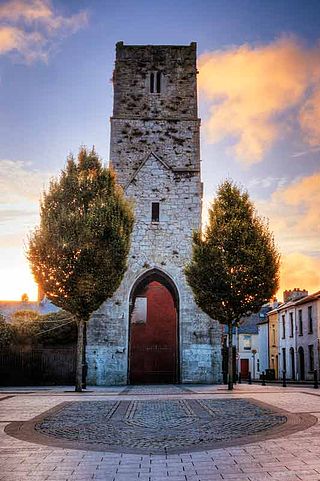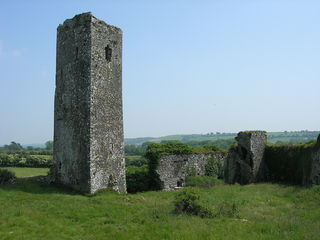
The Red Abbey in Cork, Ireland was a 14th-century Augustinian abbey which took its name from the reddish sandstone used in construction. Today all that remains of the structure is the central bell tower of the abbey church, which is one of the last remaining visible structures dating to the medieval walled town of Cork.

Dunboy Castle is a ruined 15th-century castle on the Beara Peninsula in south-west Ireland near the town of Castletownbere. The castle's tower house and bawn were destroyed in the 1602 Siege of Dunboy, though its ruins remain open to the public.

The siege of Dunboy took place at Dunboy Castle between 5 June and 18 June 1602, during the Nine Years' War in Ireland. It was one of the last battles of the war. An English army of up to 5,000 under Sir George Carew besieged the castle, which was held by a Gaelic Irish force of 143 loyal to Donal Cam O'Sullivan Beare. The English took the castle after eleven days and hanged the majority of captured prisoners. The English also captured a fort on nearby Dursey Island.

James Fort is an early 17th-century pentagonal bastion fort located on Castlepark peninsula in Kinsale harbour, County Cork, Ireland. Situated downstream from Kinsale on the River Bandon, the fort was built to defend the harbour and seaborne approaches of the town. Following the construction of Charles Fort on the opposite side of the harbour in the late 17th century, James Fort became known as the "old fort". Listed as a protected National Monument, and managed by the Office of Public Works, the fort is open to visitors.

Charles Fort is a trace italienne fortification, a bastion fort with one section of the outer wall built in star fashion. It is located at the southern end of the village of Summer Cove, on Kinsale harbour, County Cork, Ireland. First completed in 1682, Charles Fort was sometimes historically referred to as the "new fort" - to contrast with James' Fort which had been built on the other side of Kinsale harbour before 1607. The fort is now operated as a heritage tourism site by the Heritage Ireland arm of the Office of Public Works.

The de Barry family is a noble Cambro-Norman family which held extensive land holdings in Wales and Ireland. The founder of the de Barry family was a Norman knight, Odo, who assisted in the Norman Conquest of England and south-east Wales during the 11th century. As a reward for his military services, Odo was granted estates in Pembrokeshire and around Barry, Wales, including Barry Island just off the coast.

Barryscourt Castle is a castle located in eastern County Cork in southern Ireland, close to the town of Carrigtwohill.

Dunkerron Castle is a ruined four-storey tower house located in Templenoe, near Kenmare, County Kerry, in south-west Ireland. The castle was the family seat of the O'Sullivan Mór family from the late 16th century.

Ballincollig Castle is a Norman castle to the south of the town of Ballincollig, County Cork, Ireland, built after the Norman invasion of Ireland. In its prime, the castle was inhabited by the Barrett family, who had control of the local area. The castle still stands today, albeit largely in ruin. The original keep still remains, as does most of the curtain wall and two towers.

Shandon is a district on the north-side of Cork city. Shandon lies north of the River Lee and North Gate Bridge, the northernmost point of the medieval city. Several landmarks of Cork's north-side are located in the area, including the bell tower of the Church of St Anne, the Cathedral of St Mary and St Anne, Saint Mary’s Dominican Church & Priory, and Firkin Crane Arts Centre.

The Church of St Anne is a Church of Ireland church located in the Shandon district of Cork city in Ireland. Built between 1722 and 1726, it is situated on a hill overlooking the River Lee. The church tower is a noted landmark and symbol of the city, and the church bells were popularised in a 19th-century song.
The post of Lord President of Munster was the most important office in the English government of the Irish province of Munster from its introduction in the Elizabethan era for a century, to 1672, a period including the Desmond Rebellions in Munster, the Nine Years' War, and the Irish Rebellion of 1641. The Lord President was subject to the Lord Deputy of Ireland, but had full authority within the province, extending to civil, criminal, and church legal matters, the imposition of martial law, official appointments, and command of military forces. Some appointments to military governor of Munster were not accompanied by the status of President. The width of his powers led to frequent clashes with the longer established courts, and in 1622 the President, Donogh O'Brien, 4th Earl of Thomond, was warned sharply not to "intermeddle" with cases which were properly the business of those courts. He was assisted by a Council whose members included the Chief Justice of Munster, another justice and the Attorney General for the Province. By 1620 his council was permanently based in Limerick.

Elizabeth Fort is a 17th-century star fort off Barrack Street in Cork, Ireland. Originally built as a defensive fortification on high-ground outside the city walls, the city eventually grew around the fort, and it took on various other roles – including use as a military barracks, prison, and police station. Since 2014, the fort has seen some development as a tourism heritage site, reportedly attracting 36,000 visitors during 2015. The walls of the fort have been accessible to the public on a regular basis since September 2014.

Dominic Collins, SJ was an Irish Jesuit lay brother, an ex-soldier, who died for his Catholic faith. He was beatified by Pope John Paul II, along with 16 other Irish Catholic Martyrs, on 27 September 1993.
Philip de Barry, was a Cambro-Norman warrior from Manorbier in Pembrokeshire who participated in the colonisation of Kingdom of Desmond following the Norman invasion of Ireland. He was the founder of the Barry or De Barry family in County Cork, and common ancestor of the barons Barry and earls of Barrymore.

South Parish is the name given to both a Roman Catholic parish of Cork City and to the residential area contained within it.

Shandon Street, formerly known as Mallow Lane, is a street in the Shandon area of Cork City, Ireland and is a retail area on the North-Side of Cork city.

Castlefreke, also known as Rathbarry, is a townland and village in County Cork, Ireland. The townland is located in the civil parish of Rathbarry on the R598 regional road, to the east of Rosscarbery.

The Firkin Crane is a non-profit arts organisation based in the protected building of the same name in the Shandon area of Cork City in Ireland. It is a theatre and dance centre and is a permanent base for Cork City Ballet and Crux Dance Theatre.
![17th century map (first published 1633) showing Shandon Castle ("L[ord] Barris Castell") outside the city walls to the east of Cork's North Gate Bridge 17th Century Map of Cork - Extracted and replicated from Pacata Hibernia page 137 - Crop.png](http://upload.wikimedia.org/wikipedia/commons/thumb/b/be/17th_Century_Map_of_Cork_-_Extracted_and_replicated_from_Pacata_Hibernia_page_137_-_Crop.png/240px-17th_Century_Map_of_Cork_-_Extracted_and_replicated_from_Pacata_Hibernia_page_137_-_Crop.png)















